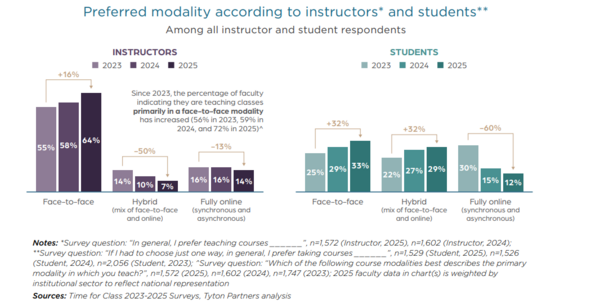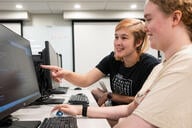You have /5 articles left.
Sign up for a free account or log in.

A larger number of faculty are using generative AI tools, but their usage still lags behind students’ and administrators’ use.
Supatman/iStock/Getty Images Plus
A recent study from Tyton Partners finds that while large numbers of higher education stakeholders are engaging with generative AI tools, they still show a strong preference for in-person instruction, human-led support and skills-based learning over other trends.
“It’s re-norming,” said Catherine Shaw, managing director of Tyton Partners. “People are figuring out how to adjust to this innovation that supports all the stakeholders in the ecosystem. [Generative AI] can be beneficial to learners, it can be beneficial to faculty and it can be beneficial to solution providers.”
“Time for Class,” Tyton’s annual report on digital tools and student success, evaluated survey responses from students, administrators and faculty members over the past three years regarding generative AI and other innovations in higher education.
This year’s report highlighted the value of in-person learning and face-to-face engagement for student success, as well as the ways faculty and staff can leverage tech tools to enhance the student experience.
Methodology
“Time for Class” is a longitudinal study of digital learning in U.S. higher education. This year’s survey was conducted in spring 2025 and includes responses from 1,500 students, more than 1,500 instructors and over 300 administrators. The students surveyed attend two- and four-year colleges and include working students, parenting students and dually enrolled high school students.
In addition to asking about generative AI use, the survey collected data about digital courseware, ebooks and inclusive access, as well as changes to digital accessibility compliance requirements.
Getting a grip on AI: The rise of generative artificial intelligence tools has soured students’ and faculty members’ perspectives of education, with each group accusing the other of using AI to cheat. In spite of a growing marketplace for digital tools and AI-assisted alternatives, the study found that both students and instructors prefer to engage in person and with other humans.
Just under two-thirds of faculty and one-third of students surveyed indicated that face-to-face courses were their preferred method of teaching and learning, respectively. Compared to 2023 data, 16 percent more instructors indicated they prefer face-to-face teaching, and 32 percent more students said they wanted to learn in person.
At the same time, preference for fully online courses fell among faculty from 16 percent in 2023 to 14 percent in 2025; for students it dropped from 30 percent in 2023 to 12 percent in 2025.

Students were also less likely than a year ago to say they primarily turn to generative AI tools for help when they’re struggling in a course. A majority (84 percent) said they turn to people when they need help, while 17 percent said they use AI tools—a 13-percentage-point decrease from spring 2024 respondents.
Researchers theorize this may be due to the difficulty students experience in prompting AI tools to help explain classroom concepts.
“Understanding concepts, AI might not be the best for,” Shaw said. “Getting answers? AI might be able to help you with that. There’s a pretty striking difference there, and I think our learners are showing us they’re starting to understand that.”
About one in three faculty members assume students are turning to AI tools for support. Twenty-nine percent of instructors think students prioritize help from generative AI, while 86 percent say they turn to people for help. Roughly two-thirds of students say they use a stand-alone generative AI tool like ChatGPT, and 30 percent say they use embedded courseware tools that incorporate generative AI.
Instructors still lag in regular use of AI, with 30 percent of professors saying they use generative AI tools at least weekly, compared to 42 percent of students and 40 percent of administrators.
The increased access to generative AI tools has not alleviated faculty workloads; half of faculty respondents said their workload has seen no change and 38 percent indicated AI is actually creating more work for them. The additional work includes monitoring cheating (71 percent) and creating assessments to counter student AI usage (61 percent). The only exception was among faculty who said they use generative AI tools very frequently or daily: One-third of those respondents said their workload has decreased.
Immediately after the launch of ChatGPT, faculty and administrators at many institutions hurried to create policies about student use of generative AI and academic dishonesty. A May 2024 survey by Inside Higher Ed found that 31 percent of students said they weren’t clear on when they’re permitted to use generative AI in the classroom. As of spring 2025, only 28 percent of institutions had a formal policy on AI, while 32 percent said they’re still developing a policy, according to Tyton’s report.
“Institutions are perhaps hesitant to set a central policy, because there’s so many ways this could be used to a student’s advantage and disadvantage, dependent on the field of study and the specific class, even,” Shaw said. “You want your guidance to be strong enough to be understood by everyone, but also with enough leeway that folks can feel free and have agency to modify as it makes sense for them.”
While only 4 percent of administrators agreed that student literacy of generative AI is measured as a learning outcome at their institution currently, 39 percent indicated it will be in the next three years.
The human element: Despite students’ reported interest in working with others, the faculty surveyed indicated that student engagement is low and academic dishonesty is on the rise.
Among instructors who teach introductory or developmental courses, 45 percent said their primary classroom challenge is preventing students from cheating. An additional 44 percent said student attendance was their greatest concern.
When asked what hinders students’ success in the classroom, 70 percent of instructors said they have ineffective study skills and 47 percent said they lack prerequisites for their course. Faculty also saw students’ personal challenges, such as feeling anxious or overwhelmed (48 percent) or lacking motivation (38 percent), as barriers to their success. Many students agreed with their professors’ assessment; 32 percent of first-year students and 28 percent of continuing students said they lack motivation in the classroom.
The lack of motivation could be tied to a lack of career connections in their academics, particularly for students in introductory or general education courses, Shaw said. But this challenge could also motivate students to get in the classroom and engage with others so they don’t have to struggle alone, she added.
“Perhaps the reason some students want more face-to-face interaction with their peers or with their instructor, it’s that feeling … of frustration or a lack of confidence … It’s easier when you are in person and you can see someone struggling,” Shaw said.
Tyton’s survey asked faculty to rank different types of data they wish they had in their classroom to improve student outcomes, and the top response was “sentiment data” on students’ level of frustration or confidence (35 percent), followed by visibility into students’ grades in other courses during the term (23 percent). To Shaw, these responses suggest faculty are interested in seeing their students as whole people so they can better support them.
Seeking stories from campus leaders, faculty members and staff for our Student Success focus. Share here.




